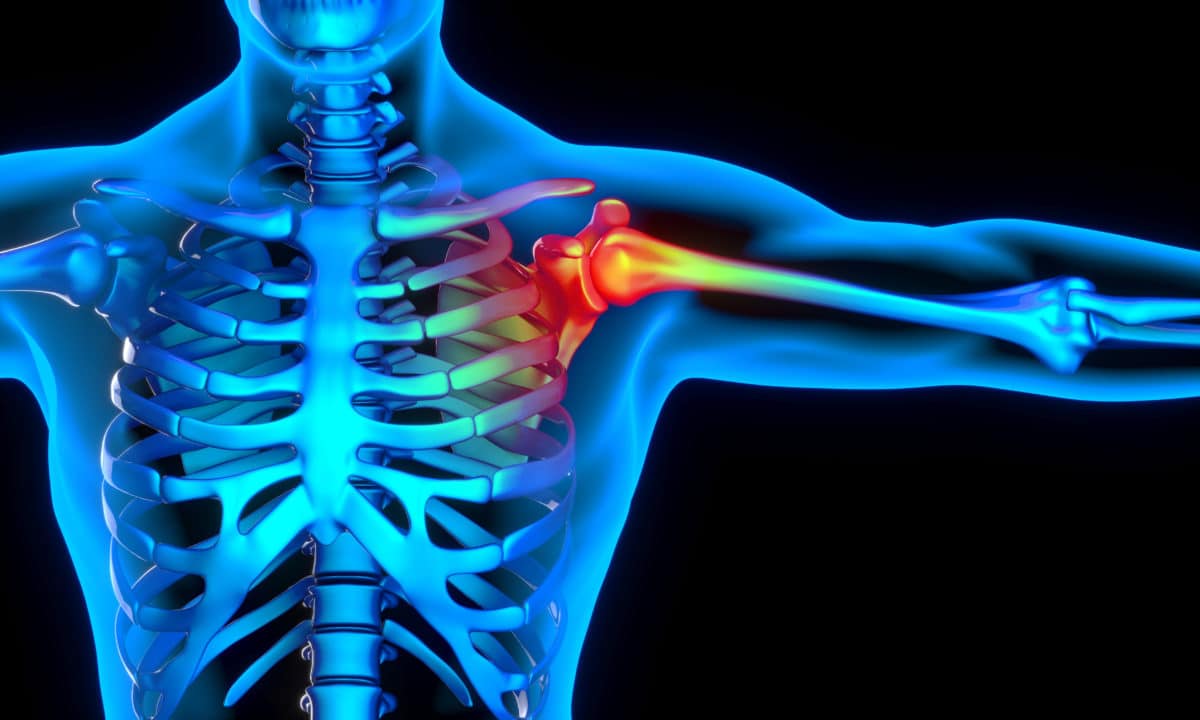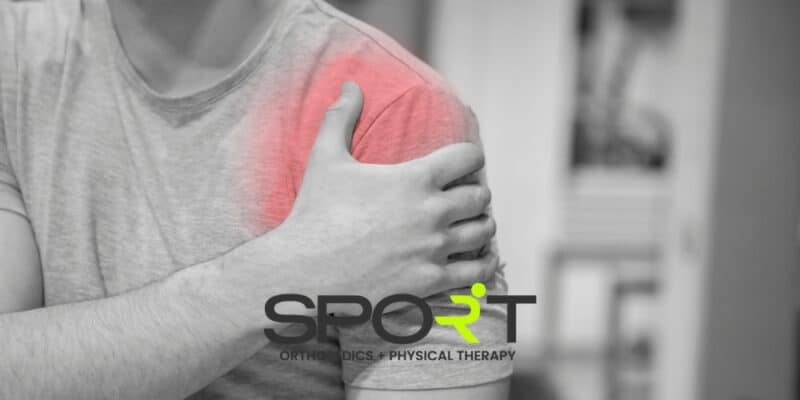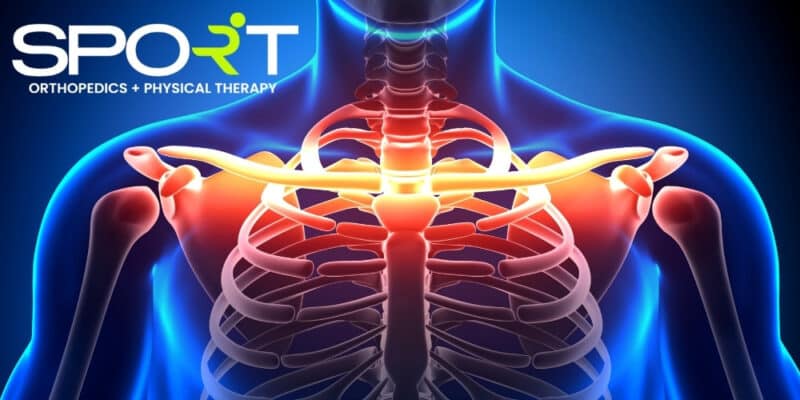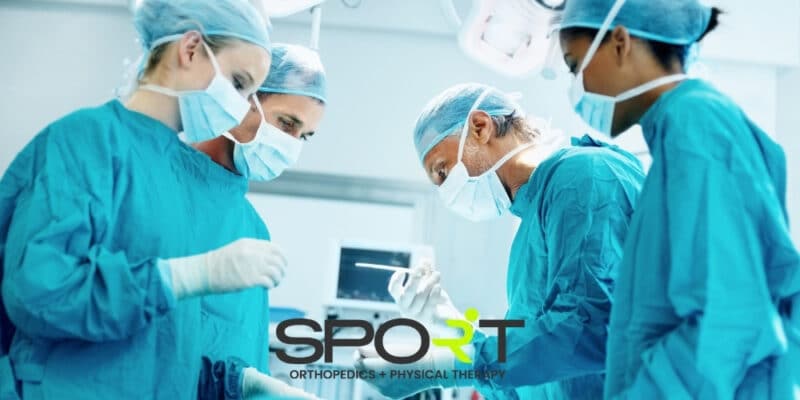Labrum Tear Shoulder Treatment in Frisco & Dallas
Shoulder Instability Treatment in Dallas
Home » Conditions » Labrum Tear Shoulder Treatment in Frisco & Dallas
Shoulder Labrum Tear Treatment in Dallas & Frisco, Texas
Oftentimes, we don’t realize just how much we move our shoulders until we are no longer able to do so. The movement of the shoulder allows us to lift and rotate our arms, giving us an extensive range of motion. However, overusing your shoulders can lead to shoulder instability and a labrum tear shoulder injury.
Shoulder instability occurs when the head of the upper arm bone slips repeatedly out of the shoulder socket. This can happen if the shoulder has been dislocated by sudden trauma or overuse of the shoulder joint, and never healed correctly. If this condition goes untreated, the shoulder can become even looser and more unstable.
SPORT Orthopedics + Physical Therapy proudly employs renowned Dallas orthopedic specialists who treat hundreds of shoulder instability and labral tears yearly. We also perform a wide variety of shoulder surgeries, including torn rotator cuff surgery and Bankart repair. If you believe you have a shoulder injury, contact us at SPORT Orthopedics in Dallas, Texas. Call our office today at 469-200-2832.
Shoulder Anatomy
The shoulder is a ball-and-socket joint, which gives it a higher level of mobility, but a lower level of stability. The labrum of the shoulder is extremely important in maintaining shoulder stability. In fact, the shoulder can’t function properly without the labrum. It is made up of fibrocartilage, which is a type of rubbery tissue that connects to the shoulder socket, holding the “ball” of the shoulder joint in place in the “socket.” While the ring of cartilage that makes up the labrum is thick, it can still suffer a tear if the shoulder experiences trauma.

What Is a Labrum Tear Shoulder Injury?

The ball of the humerus, also known as the humeral head, sits inside a socket in the shoulder blade known as the glenoid. When you move your shoulder, the ball of the humerus rotates in this socket, giving you the range of motion you are accustomed to. Another term for a shoulder labral tear is superior labrum, anterior to posterior tear, or SLAP tear.
There is a group of ligaments known as the shoulder capsule, which hold the humerus in place in this socket. There are also muscles and strong tendons that hold the humerus in place.
Shoulder instability happens if these ligaments, muscles, or tendons are injured and become loose. The humerus will not sit snugly in the glenoid socket but will move about more freely.
This dislocation of the humerus can be partial, meaning it only comes partway out of the glenoid socket, or complete, meaning it separates from the socket completely.
Once these tissues become loose and torn and the humerus moves away from the socket either partially or completely, shoulder dislocations can become frequent, causing chronic shoulder instability.
Types of Shoulder Labral Tears
Several different types of shoulder labral tears exist, which we outline below.
- SLAP tears: This stands for superior labrum anterior posterior. The tear is located in the upper portion of the labrum, but it extends to both the front and the back.
- Anterior tears: An anterior tear occurs if the front part of the labrum is torn.
- Posterior tears: A posterior tear occurs if the back part of the labrum is torn.
- Bankart tear: A Bankart tear usually occurs along with a dislocated shoulder. This can be either an anterior dislocation or a posterior dislocation. A special surgical procedure exists for repairing a Bankart tear, called a Bankart repair.
What Causes a Shoulder Labrum Tear?
There are generally three ways in which the shoulder can become unstable:
- Shoulder dislocation. This is the most common way shoulder instability begins. Severe injury or trauma, such as a sports injury or a car crash, can cause an initial shoulder dislocation. Once the humerus becomes detached the first time, it is likely to become detached again, and again, and again, further stretching muscle and tissue that hold it into place.
- Repetitive strain. Most of the time, loose and stretched ligaments are a result of overuse. Repeated overhead motion such as swimmers, tennis players, or volleyball players engage in could cause the ligaments around the shoulder joint to stretch and become loose. This can also result in a painful, unstable shoulder joint.
- Multi-directional instability. If you’ve ever met someone who claims to be “double-jointed,” this is very likely due to the ligaments in their shoulders being looser than is common. These people are at increased risk for shoulder instability and can experience it without a history of overuse or injury.
What Does a Labral Tear in the Shoulder Feel Like?
Common symptoms of shoulder instability include:
- Shoulder pain
- Repeated shoulder dislocations
- Repeated instances of the shoulder “giving out”
- A persistent feeling of the shoulder moving loosely inside the joint, slipping in and out of the socket, or just “hanging there”
How Do I Know If I Have a Shoulder Labrum Tear?

Shoulder instability will likely be diagnosed through a combination of physical examination and imaging tests.
One of our Dallas orthopedic surgeons will discuss your symptoms and medical history with you, and examine your shoulder. There are simple tests that will enable them to test for looseness in the ligaments, such as asking you to touch your thumb to the underside of your forearm.
To confirm the diagnosis, your doctor will probably order X-rays of the shoulder joint, or an MRI to provide detailed images of soft tissues to determine any damage to the ligaments and tendons that surround the shoulder joint.
How to Diagnose a Shoulder Labrum Tear
Although most doctors will begin with a physical exam of your shoulder, this rarely gives sufficient information for a diagnosis. This is mostly because of how deep in the shoulder a shoulder labral tear is. We may begin by manipulating the affected shoulder in certain ways, looking for initial signs of labral tears. However, we often order imaging tests to diagnose shoulder labrum tears.
The two most popular imaging tests for a shoulder labral tear are magnetic resonance imaging (MRI) scans and CAT scans in which we inject a special dye near the torn labrum. Even with such advanced imaging tests, it can still be difficult to identify what kind of labral tear you have. Your doctor may opt for diagnostic arthroscopic surgery, which will allow them to see inside your shoulder for the most accurate diagnosis.
Shoulder Labrum Tear Treatments
The first step of treatment for shoulder instability will be a host of nonsurgical options. Only if these options fail will surgery be used as treatment.
Nonsurgical Treatment for Shoulder Labrum Tear
Nonsurgical treatments will often take several months to produce results. Some of these treatments will include:
- Activity modification. Dr. Berry or Dr. O’Brien may advise you to make some changes to your lifestyle and activity level and avoid activities that aggravate the symptoms of shoulder instability.
- Non-steroidal anti-inflammatory medication. Drugs such as aspirin and ibuprofen can be used to reduce pain and swelling.
- Physical therapy. Strengthening your shoulder muscles and working on shoulder control can increase the stability of the joint. A physical therapist can design a home exercise program tailored to your needs and the severity of your injury.
Can a Shoulder Labral Tear Heal Without Surgery?
It is possible for a labral tear in the shoulder to heal without surgery. However, shoulder injuries affect each person differently. If you don’t need to use your injured shoulder for your job or for sports, you can probably get away with medication, shoulder injections, and working with a physical therapist.
However, those who wish to get back to playing sports as soon as possible may need an arthroscopic repair of the labral tear. Arthroscopic orthopaedic surgery allows surgeons to repair traumatic injuries with as smooth a recovery as possible. Below, we list the most common forms of labral tear surgery.
- Bankart repair
- Laterjet procedure
- SLAP tear repair
- Posterior labral repair
- Anterior and posterior repair
Surgical Treatment for Shoulder Labrum Tear

Surgery can be necessary when ligaments are torn and stretched beyond their ability to repair themselves. There are several methods of surgical treatment that can be used to heal shoulder instability:
Shoulder Arthroscopy. Small cameras are used to guide tiny surgical tools that will repair soft tissues in the shoulder. This is a minimally invasive surgery in which only small incisions are used by the orthopedic surgeon. Arthroscopic surgical repair generally involves less pain and downtime than open shoulder surgery.
Open surgery. In some more severe cases, open surgery may be required. In open surgery, a larger incision will be made over the shoulder, and your surgeon will repair torn or stretched ligaments manually under direct visualization. Depending on the type of tear, your orthopaedic surgeon will determine which surgical solution is best for you.
How Long Does it Take To Recover from a Labrum Tear in the Shoulder?
Recovery from nonsurgical treatments will depend on the plan created by Dr. Berry and your physical therapist.
After undergoing surgery, we will place your arm in a sling to stabilize it. After we remove the sling, you will need to begin physical therapy to help strengthen the shoulder muscles and regain a full range of motion. This can also prevent scarring as the ligaments heal.
Your commitment to physical therapy is overall the most important factor in your recovery.
Can Shoulder Labral Tears Be Prevented?
It’s important for younger athletes to understand how to prevent common shoulder injuries, such as SLAP tears, torn rotator cuff tendons, superior labral tears, and Bankart tears. Working with a skilled physical therapist can help you better understand how to avoid injuries and instability in the shoulder. Physical therapy can also help you gradually strengthen the shoulder ligaments and muscles, which usually makes injuries less likely. Keep in mind that if you exercise regularly with pushing movements, you should exercise equally with pulling movements. This will help the muscle balance in your shoulders, which can help prevent injuries.
Shoulder Labrum Tear Treatment in Dallas and Frisco
At SPORT Orthopedics + Physical Therapy, we understand that shoulder and upper arm pain can really put a damper on your daily life. Proper shoulder function is essential for both athletes and non-athletes, as we use our shoulders for many basic tasks. If you’re suffering pain from a SLAP tear, Bankart tear, or another type of tear, contact the experts at SPORT Orthopedics + Physical Therapy today. To schedule an appointment with us, please call our office at 469-200-2832.


